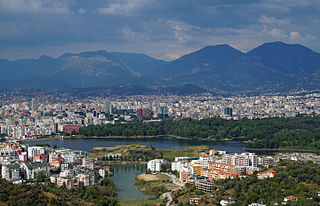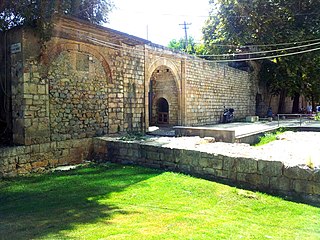
Tourism in Albania has been a key element to the country's economic activity and is constantly developing. It is characterized by its rich archaeological and cultural heritage dating back to the classical period when Illyrians and Ancient Greeks inhabited the region. Over the course of history, the territory of Albania was occupied and populated by Romans, Byzantines, Venetians and Ottomans. Notably the country features unspoiled beaches, mountainous landscapes, traditional cuisine, archaeological artifacts, unique traditions, low prices and the wild atmosphere of the countryside.

Tirana County is one of the 12 counties of the Republic of Albania, with the capital in Tirana. The county spans 1,652 square kilometres (638 sq mi) and had a total population of 883.996 people as of 2018. The county borders on the counties of Durrës, Dibër, Elbasan, Fier, and the Adriatic Sea. It is formed by Tirana district where Tirana sits, and Kavaja district on the coast.

The Catholic Church in Albania is part of the worldwide Catholic Church, under the spiritual leadership of the Pope in Rome.

Berat Castle, also referred to as the Citadel of Berat and castle quarter, is a fortress overlooking the town of Berat, Albania. It dates mainly from the 13th century and contains many Byzantine churches in the area and Ottoman mosques. It is built on a rocky hill on the left bank of the river Osum and is accessible only from the south. It is situated at an elevation of 214 metres (702 ft).

Fortress of Justinian or simply known as Tirana Castle is a castle in Tirana, Albania. Its history dates back before 1300 and is a remnant from the Byzantine-era. The fortress is the place where the main east-west and north-south roads crossed, and formed the heart of Tirana. The current fortification has three known towers and it is undergoing a process of restoration, for touristic purposes. Inside the fortified walls of the former fortress, there are many buildings that can be visited, including restaurants, hotels, and cultural institutions.

Mesi Bridge is a bridge in the village of Mes, about 5 km (3.1 mi) northeast of Shkodër, in northwestern Albania. It is a monument of Postribë culture, turning the site into a tourist attraction with a lot of visitors from all around the world. For foreigners the architecture of the bridge is intriguing with round slick stones and stone plates. The surrounding panorama gives the bridge an even more picturesque view. The Albanian Development Fund invested 13 million lekë so the tourists could step on the bridge and watch it closely because there was no entry way to the bridge.

St. Theodore's Church is an Orthodox church in Berat Castle, Berat, Albania. It became a Cultural Monument of Albania in 1948.
The Dormition Cathedral is an Orthodox church in the Berat Castle in Berat, Albania, dedicated to the Dormition of the Theotokos. It is a Cultural Monument of Albania since 1948. Since 1986, the Onufri Museum of Icons is located in the church.
The ruined St. Mark's Church is a Cultural Monument of Albania, located in Vau i Dejës Castle, Vau i Dejës.
Vau i Dejës Castle is a ruined castle in Vau i Dejës, northern Albania. The ruined St. Mark's Church inside the castle is a Cultural Monument of Albania.
Demetrio Franco it is not known of him the date of birth or death. It is a Historical figure and historian. Demetrio Franco, known by the Albanian neologism of Dhimitër Frangu,was born in Drivasto (Drisht) ofa Catholic family. He was a cousin of Paulus Angelus, who was archbishop ofDurrës and a close collaborator of Scanderbeg. Franco it was contemporary and in the service of Scanderbeg, and himself accompanied Scanderbeg to Italy in the winter of 1466–1467. After the death of Scanderbeg on 1468, Franco moved to Tivar and then to Venice, where he wrote in Latin and published the biography of Scanderbe, on 2 April 1480, at the printing house of the German Erhard Ratdolf 12 years after Scanderbeg's death. His foremost work is considerered to be Gli illustri e gloriosi gesti e vittoriose imprese fatte contro i Turchi dal Signor Don Georgio Castriotto detto Scanderbeg, principe d' Epiro, published also with the titleComentario de le cose de' Turchi, et del S. Georgio Scanderbeg, principe d' Epyrro, a biography of the national hero of Albania Skanderbeg.

The Siege of Shkodra of 1478–79 was a confrontation between the Ottoman Empire and the Albanians and Venetians at Shkodra and its Rozafa Castle during the First Ottoman-Venetian War (1463–79). Ottoman historian Franz Babinger called the siege “one of the most remarkable episodes in the struggle between the West and the Crescent.” A small force of approximately 1,600 Albanian and Italian men and a much smaller number of women faced a massive Ottoman force containing artillery cast on site and an army reported to have been as many as 350,000 in number. The campaign was so important to Mehmed II “the Conqueror” that he came personally to ensure triumph. After nineteen days of bombarding the castle walls, the Ottomans launched five successive general attacks which all ended in victory for the besieged. With dwindling resources, Mehmed attacked and defeated the smaller surrounding fortresses of Žabljak Crnojevića, Drisht, and Lezha, left a siege force to starve Shkodra into surrender, and returned to Constantinople. On January 25, 1479, Venice and Constantinople signed a peace agreement that ceded Shkodra to the Ottoman Empire. The defenders of the citadel emigrated to Venice, whereas many Albanians from the region retreated into the mountains. Shkodra then became a seat of the newly established Ottoman sanjak, the Sanjak of Scutari. The Ottomans held the city until Montenegro captured it in April 1913, after a six-month siege.
The Statutes of Drivasto were the highest form of expression of self-government in the Albanian village of Drisht during the Middle Ages. Titled "Statuta et Ordinationes Capituli Ecclesiae Cathedralis Drivastensis", they were unique for the fact that the power of city governance was concentrated in the hands of the bishop of the Drisht Cathedral.
Drishti and similar may refer to:

The Architecture of Albania is a reflection of Albania's historical and cultural heritage. The country's architecture was influenced by its location within the Mediterranean Basin and progressed over the course of history as it was once inhabited by numerous civilisations including the Illyrians, Ancient Greeks, Romans, Byzantines, Venetians, Ottomans as well as modern Austro-Hungarians and Italians. In addition, missionaries, invaders, colonisers and traders brought cultural changes that had a large profound effect on building styles as well as techniques.









